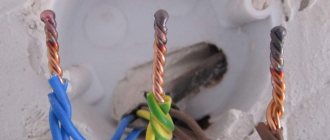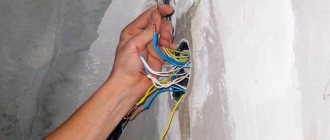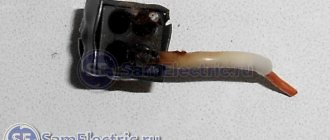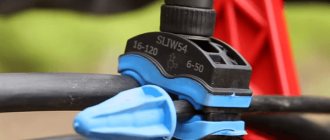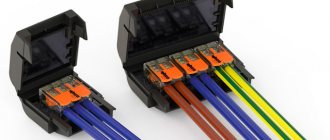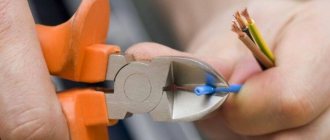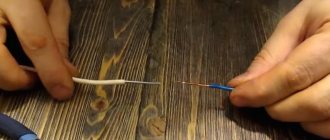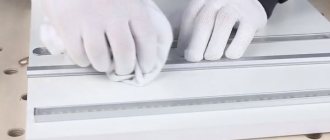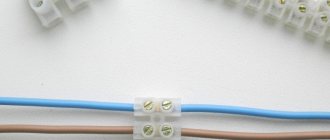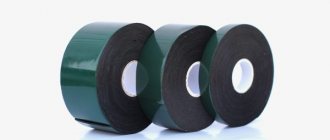Branch clamp "walnut" type
When carrying out electrical installation work that is associated with the commissioning of new electrical equipment or laying electrical wiring, there is a need to connect a cable line extending from the main cable. To make a branch from the main cable, special devices are used - branch clamps, which are also known as “cable nuts”. They are widely used when installing electrical networks for household and industrial purposes, connecting lighting equipment, etc.
As an electrician, I often have to deal with the problem of lack of voltage. And it must be said that 60% of the consumer’s lack of voltage problems are due precisely to poor contact in panels, distribution boxes and other power points.
Of course, an important fact in all these problems is that over the last half century the electrical load of household consumers has increased sharply. Each home has water heaters, electric kettles, hobs, washing machines and other powerful equipment. We try to make our environment as comfortable and cozy as possible.
Compared to the last century, when twisting was used almost everywhere, today there are many known methods for high-quality connection of electrical wires: various self-clamping and screw terminal blocks, crimping wires with sleeves. soldering, welding.
If we consider the topic of connecting wires, we cannot but ignore one very practical way of connecting wires using nut-type clamps.
Squeeze the branch “nut”: what and how will it connect in 2021?
Often, when connecting a house or apartment to the electrical network, it is necessary to connect branches to the main power lines. At the entrance of an apartment building, the risers of the circuits are located in the electrical panel on the landing. You can connect an apartment to them in several ways: make a twist, use terminal blocks or a “nut” branch clamp. Advantages and disadvantages of the latter option, rules for using the device.
What is the device
“Nut” is the most popular of all existing compressions. It is represented by a two-plate clamping die made of anodized steel. Each plate is equipped with grooves for connecting wires. The device holds its shape due to 4 screws.
The die is closed by a carbolite box, consisting of 2 parts and secured by a pair of ring springs. Due to this design, compression performs two tasks:
- Connects.
- Protects.
The advantage of the nut is that it provides a connection between an aluminum wire and a copper cable without cutting the line. In other cases, this cannot be done without a brass spacer plate, because the connection quickly oxidizes. A small area will need to be cleaned so that it fits into the die. The connection is made into a perpendicularly located gutter.
However, branch compression has some disadvantages. First, the wires to be connected will need to be exposed. For piercing-type compressions, this will not be necessary. Secondly, the degree of protection of the nut is IP20 - the minimum value. This means that it can only be used under normal conditions - indoors, but is not suitable for outdoor use.
Walnut comes in different sizes. Therefore, using the device, you can connect electrical conductors of different cross-sections. The choice of “nut” depends on the cross-section of the main and branch cables.
Table: Types of connecting cables and their corresponding conductors
| Branch compression model | Line cross-section, mm2 | Coupler cross-section, mm2 |
| U731M | 4*10 | 1,5*10 |
| U733M | 16*35 | 1,5*10 |
| U734M | 16*35 | 16*25 |
| U839M | 4*10 | 1,5*2,5 |
| U859M | 50*70 | 4*35 |
| U870M | 95*150 | 16*50 |
| U871M | 95*150 | 50*95 |
| U872M | 95*150 | 95*120 |
How to use
To connect the conductor to the main electrical cable, you need to disassemble the nut. To do this, you need to remove its side retaining rings, and then unscrew the bolts connecting the dies and the compression core. Next you need to peel off the insulating layer from the cable. The size of the exposed area must strictly correspond to the length of the compression core.
The exposed areas are inserted into the grooves of the dies and tightened with screws. The assembled structure is placed in a polycarbonate “nut” box. A branch cable is inserted into one of the 3 unsoldered holes in the housing, and the main electrical conductor is inserted into the other two.
Due to the low degree of protection, nut-type compression does not guarantee the tightness of the connection. To prevent moisture and dust from getting inside the device, the case must be additionally wrapped with electrical tape.
Nut for connecting wires
Connecting wires using nut-type clamps is quite common. They are widely used in floor distribution panels to divert power from main lines to apartments. Such a clamp is correctly called a branch clamp, and electricians called it the word “nut”, since it is very similar in appearance.
Connecting wires through the “nut” is very simple, but if you want to learn more about this connection, then read this article.
What are branch clamps intended for?
Their main task is to make branches from different main wires without cutting the conductor itself. Those. At the connection point on the main wire, the insulation is removed and a clamp and branch conductor are attached to this place. They are used in networks with voltages up to 660V.
Here is an example of some floor panels with “nuts”
“Nuts” consist of a metal core and a dielectric polycarbonate body. The core consists of two dies and an intermediate plate, connected to each other with bolts. Each die has a groove for a certain cross-section of wire.
In order to choose the right compression, you need to know the cross-section of the conductors being connected. Below I post a table from which you can quickly select the desired type of “nut”.
| Branch compression type | Cross-section of main wires, mm 2 | Section of branch wires, mm 2 | dimensions |
| U731M | 4-10 | 1,5-10 | 42x41x31 |
| U733M | 16-35 | 1,5-10 | 42x41x31 |
| U734M | 16-35 | 16-25 | 42x41x31 |
| U739M | 4-10 | 1,5-2,5 | 42x36x23 |
| U859M | 50-70 | 4-35 | 62x61x43.5 |
| U870M | 95-150 | 16-50 | 84x85x60 |
| U871M | 95-150 | 50-95 | 84x85x60 |
| U872M | 95-150 | 95-120 | 84x85x60 |
Branch clamps are sold in any electrical goods stores. They can be used to connect copper and aluminum wires. A combination of them is also possible, i.e. You can connect a copper to an aluminum conductor through an intermediate plate.
Also remember that the nut-type compression housing is not sealed and water, dust or small debris can easily get in there. Therefore, for reliability, it is worth insulating them with electrical tape.
Connecting wires using walnut clamps
Now let's look at the connection process itself.
First you need to disassemble the compression housing. To do this, use a thin screwdriver to pry up the retaining rings and remove them.
We strip the wires to the length of the dies and loosen (unscrew) the bolts.
We insert the wires into special grooves in the dies. If you connect an aluminum wire to a copper wire, there must be an intermediate plate between them. Copper and aluminum should not be in direct contact, as this will cause rapid oxidation of the metals and subsequently there will be poor contact at the junction.
Tighten the bolts so that you can no longer climb there, but carefully so as not to strip the threads
Now we put the die with the wires into the “nut” body. There are special holes in it for the passage of conductors.
We close the case and put on the locking rings so that it does not open.
That's all! We connected the two wires using nut clamps.
The branch wire is connected to the main wire in the same way. Only at the main line part of the insulation is removed without cutting it.
Today, in floor panels, most of these connections are in a deplorable state, since no one is monitoring them. This can be seen in the top two photographs. Often, in addition to the main conductors, they are connected to an intercom, entrance lighting, some kind of socket, signalmen their equipment, etc. Usually they do all this at random and do not pursue the goal of making a reliable connection.
What condition are the “nut” type compressions in your floor panel?
{SOURCE}
Branch clamps (nuts)
| Here's a banner |
| Branch clamp U731M (4-10/1.5-10mm2) U731M Schneider Electric Article: U731M Branch compressor U731M (4-10/1.5-10mm2) Schneider Electric Schneider Electric (Schneider Electric) | Branch clamp U733M (16-35/1.5-10mm2) U733M Schneider Electric Article: U733M Branch clamp U733M (16-35/1.5-10mm2) Schneider Electric Schneider Electric (Schneider Electric) |
| Branch cable clamp U733M (compression) 16-35/1.5-10 KW Article: 61641 Branch cable clamp (KVT) for main wires with a cross-section from 16 to 35 mm2 and branch wires with a cross-section from 1.5 to 10 mm2. | |
| Branch cable clamp U734M (compression) 16-35/16-25 KW Article: 61642 Branch cable clamp (KVT) for main wires with a cross-section from 16 to 35 mm2 and branch wires with a cross-section from 16 to 25 mm2. | |
| Branch cable clamp U739M (compression) 4-10/1.5-2.5 KW Article: 61643 Branch cable clamp (KVT) for main wires with a cross-section from 4 to 10 mm2 and branch wires with a cross-section from 1.5 to 2.5 mm2. | |
| [td] Branch cable clamp U859M (compression) 50-70/4-35 KW Article: 61644 Branch cable clamp (KVT) for main wires with a cross-section from 50 to 70 mm2 and branch wires with a cross-section from 4 to 35 mm2. |
Installation of networks using sleeves
This option claims to be the most reliable connection method. Any load and quality of wires.
Crimping wires with sleeves
The conductive wires are inserted into a special tube - a sleeve, and crimped with a certain force. There is one thing, but. The cross-section of the wires should not exceed the cross-section of the mounted sleeves. Having inserted and crimped the clip, the sleeve is carefully insulated with heat-shrinkable tubing or other insulating materials.
Overall rating. A great way to securely connect wires. The direction of the conductors can be on different sides of the tube or on one side. The sleeves are quite inexpensive. A good way to reliably connect wires to each other.
There are also disadvantages. Disposable use of sleeves, they are not dismountable. To carry out such work you will need a tool: pressing pliers, which are also used as a special tool. They remove the insulation. They have a crimping device in their arsenal, and electrical installation work takes a little longer.
Twist connection
If for some reason you do not have the opportunity to use other methods of connecting electrical wires, you can use twisting, just do it well. Very often it is used as a temporary option and is subsequently replaced by more reliable switching methods.
How to connect wires using twist? To begin with, the cores are stripped to 70-80 mm. The main thing is to twist all switched conductors into one single twist at the same time, and not wind one around the other.
Many people mistakenly begin to twist the wires together from the place where the insulating layer ends. But it is better in this place to clamp both wires with one pair of pliers, and with the other, grab the ends of the wires and perform rotational movements in a clockwise direction.
If the wire cross-section is small, you can twist it by hand. Align the conductors along the cut of the insulation and hold them firmly in this place with your left hand. Bend all switchable ends into one single bend at an angle of 90 degrees (a bend length of 10-15 mm will be enough). Hold this bend with your right hand and rotate clockwise. This must be done firmly and firmly. If it is already difficult to twist your hands at the end, use pliers as described above. As soon as the twist becomes smooth and beautiful, you can trim the bend.
You can connect several wires this way, but then to make it easier to twist them, make the bend longer, somewhere around 20-30 mm.
How to properly twist wires is shown in this video:
There is also a way to twist wires using a screwdriver, see about it here:
For information on twisting wires using a special tool, see here:
Now the resulting twist must be carefully insulated. Electrical tape is used for this. Do not spare it, wind it in several layers, and insulate not only the connection itself, but also step 2-3 cm over the core insulation. This way, you will ensure the insulating reliability of the twist and protect the contact connection from moisture.
You can also insulate the connection of wires using heat pipes. The main thing is not to forget to put the tube on one of the cores to be connected in advance, and then push it into the place where it is twisted. When exposed to heat, the thermal tube shrinks, so slightly heat its edges and it will firmly grip the wire, thereby providing reliable insulation.
If the twisting is done well, there is a chance that it will serve you for many years, provided that the load current in the network is normal. But it’s still better not to stop at this stage and strengthen the joint by welding or soldering.
Connector design
You should start by getting acquainted with the internal structure of the product, studying which will help you understand the principle of the formation of a branch and why it is called that. The fact is that in its shape this connector with steel clips is very similar to a nut (photo below).
This connector consists of the following parts:
- The dielectric outer shell is oval in shape, which is the body of the product with latches located on it.
- A kind of “core”, which is a structure of metal plates held together with bolts.
After disassembling the nut, two dies are visible with recesses (grooves) on each of them, intended for fixing and clamping the bare ends of the wires. Their depth and width depend on the section for which the branch compression sample is designed. The most common models of products of this class and the cross-sections of the cores fixed in them are indicated in the table below.
The samples of “nut” type compressions given in it are used in alternating current networks with operating voltages up to 660 Volts inclusive.
Compression design
The branch compression device is as follows: a metal core is located in a dielectric housing made of polycarbonate (a material belonging to the group of thermoplastics, which is a polyester of carbonic acid and dihydric alcohols). This core includes two dies, as well as a plate between them. All parts are connected with coupling bolts. Both dies have grooves where the wires are laid. The selection of “nut” is made depending on the cross-section of the main and branch cable/wire. The marking of the terminals can be as follows: U731M, U733M, U734M, U739M, U859M, U870M, U871M, U872M. The table below summarizes the existing types of connection terminals and conductor sizes corresponding to each model:
Methods for connecting aluminum and copper wires
There are many situations in which there is an urgent need to organize such connections. And it is not always possible to quickly and easily replace old aluminum wiring in a house with new copper wiring. If, when trying to connect new electrical equipment, it turns out that the wiring in the house is aluminum, then be sure to use one of the available connectors.
We list the main types of electrical connectors for different conductors:
Terminal block (terminal block)
These devices deserve a separate article for consideration, but for now let us draw your attention to the main nuances of their operation. For reliable contact of aluminum and copper conductors in a screw or self-clamping type device, it is necessary to make plates from neutral materials
Alternatively, their surface should be coated with a special paste made exclusively for such actions. This information must be indicated on the label or in the instructions for the product. "Nuts." We wrote about them above. The products got their name due to their structure: the role of the shell is played by a plastic body made of carbolite, the filling is played by clamping plates for good contact. You can use branch clamps without any problems. To begin with, the aluminum conductor line is stripped at the commutation point, after which it is placed in the channel of one of the clamping plates. The copper core of the new equipment is installed in another plate without contact with the external channel. Products with a cross section of 120-150 sq. mm are used mainly by professional electricians, 1.5-4 sq. mm - at home. The piercing clamp is connected directly to the self-supporting insulated wire (SIP) on the main line. It is best to entrust the implementation of such branches to qualified specialists. If you decide to do this yourself, then the device should be connected to the conductors without breaking the insulation (without stripping the cable). Tighten the nut firmly, which will pierce and ensure contact. A homemade connector can be made from one bolt, three brass washers, a nut and electrical tape. To connect aluminum and copper conductors, the area of their direct contact is separated by three washers. This method is considered a temporary connection, but in fact the node will last for several decades.
What are branch compressions?
Branch clamps are characterized by a wide variety of designs and shapes, but in most cases they are referred to as so-called “nut” connectors. Structurally, we are talking about two clamping plates, which are made from high-quality anodized steel. Each of them has special recesses for the cable. Once it is positioned between the plates, they are compressed tightly by tightening four screws.
The clamping plates are hidden in a durable housing made of carbolite, a special type of plastic. Like the squeeze, the housing is made up of two separate parts. The plates are placed inside it: each is attached to one of the halves of the housing using a ring spring. All connections are hidden inside. The “nut” for connecting wires acts as a connecting and protective device.
The main advantage of the electrical component is the ability to reliably and safely switch aluminum and copper cables. To make such a connection there is no need to cut the main line. It is enough to strip a small part of the cable that will fit inside the die. The branch is attached to a perpendicular gutter.
“Nuts” are available in different sizes with identical technical characteristics. The dimensions of a particular product are selected in accordance with the cross-section of the core of the branch conductors. In accordance with GOST, clamps of 4-150 are selected for main lines, and 1.5-120 sq. for branches. mm.
Connector markings
How to choose a cap? After all, their sizes and twist sections are different and are classified according to the total cross-sectional area of the cores. This area is indicated by the connector number, which can be from one to five. The higher the number, the more wires the cap can connect.
But you need to be careful with such numbers, since there are two types of devices: domestic and European. The designation for both standards is the same - numbers, only European denominations are much smaller than domestic ones
Therefore, when buying PPE, it is better to pay attention to the total cross-section than to its number. All this is written on the packaging
Product marking is carried out as follows: first, the abbreviation PPE is written down, then the type of body is marked (with or without protrusions). The protrusion is necessary for better fixation of the clamp with your fingers. After the housing type, the total cross-section of the wires that are connected in the clamp is written down. The cross section ranges from 0.5 to 10 mm2. As a rule, depending on the type and size of the product, their cases are painted in a certain color to make it convenient to use the caps. The table below indicates the color scheme depending on the type of case, which will make it clearer to you how to choose PPE for twisting:
It should also be remembered that caps can only be used when two identical wires are connected. If you need to connect wires made of aluminum and copper, then it is no longer possible to do this using PPE. In this case, you can use a terminal block, a metal clamp (nut) or a bolt.
What is it used for?
The main purpose of the compression will be to create a branch on the highway without making a break on the main highway. The “nut” connector is mounted at the installation site of the trunk with the wiring of new equipment; there is no need to cut the cable. It is one of the best options when connecting conductors of different sections, which are made of aluminum and copper.
Important! Branch clamps are used during the installation of electrical networks at home and in production. They are important during electrical installation of lighting devices. “Nuts” are also used in electrical networks with a voltage of no more than 660 V.
It is also allowed to install them in electrical panels when laying open electrical wiring and connecting low-power devices. The installation procedure is quite simple. When the required model has been selected according to the cross-section of the conductor to be fastened, the clamps are removed from the equipment. The fastening that holds the 2 components of the body is removed.
Important! It is necessary to first put the threaded ring on the electrical wire before installing it in the “nut”. Otherwise you will need to dismantle the die.
When the clamps are removed, taking into account the dimensions, calculate the length of the section where the insulation on the switched wire is removed. Marks can be made with a marker or pen.
You may be interested in this Features of insulating pliers
Using a Branch Clamp
Combining tires from different materials
Connecting copper and aluminum wires with a walnut clamp
Connecting wires using electric nuts can be done using more than one branch method. Due to the simplicity of the design and the reliability of the resulting connection, these elements are used in any sections of existing electrical networks, including distribution boxes. When using them inside installation products, you need to take into account the dimensions of the clamps themselves and select boxes of appropriate dimensions.
If it is necessary to connect aluminum and copper conductors, electrical wiring clamps “nuts” are simply irreplaceable. The need for them is explained by the following reasons:
- When aluminum and copper wires come into direct contact, the metals in the connection area oxidize over time.
- With prolonged use of the twist, it gradually breaks down and can weaken so much that the circuit through which the load current flows is completely broken.
- As a result of this destruction, the power supply to the object connected to it is completely interrupted.
When forming nut connections, first the copper and aluminum wires are stripped of insulation to the width of the plate. After this, the fasteners are first loosened, and the corresponding wires are inserted into the vacated grooves. At the final stage of assembly, they are tightened with the previously loosened screws. Due to the fact that a brass plate is placed between the copper and aluminum wires in the nut, direct contact between them is not formed.
Connecting cable clamps – nuts
There are many ways of conducting connections: twisting, using screw and screwless terminal blocks, crimping tubes and clamps. Each option is unique in its own way and has a right to exist.
Their relevance and even irreplaceability, in some cases, were fully confirmed by branch compressions, which in common parlance received a laconic and apt name - “nuts”. Branch squeezes really, in shape, resemble the southern fruit.
The protective housing of this type of compressor is a round-shaped carbolite box consisting of two identical halves. When assembled, the segments form three hollow holes (two of which form a passing channel) and one plugged outlet. The compression box is secured using removable spring rings or elastic latches included in the design.
Inside the branch nut there is a “core” consisting of two steel dies and a brass gasket. Each of the dies has a molding groove into which the conductor core is inserted. The dies have numerical markings that determine the size of the appropriate cross-section of the energy-carrying element (wire/cable). When the dies are positioned correctly, the grooves run perpendicular to each other. Both the dies and the brass intermediate plate have four symmetrical screw holes, complete with threaded clamping elements, with a universal working groove (+/-).
Branch electrical installation elements of this type are especially relevant when working on central power supply lines. They perform the task of installing new branch lines without breaking the main conductor. This maintains the functional integrity of the entire circuit, even if one of the sections connected to it fails.
Nut clamps are indispensable in cases of connecting conductor lines whose wire cores are made of different metals (copper, aluminum). Tinned surfaces of the clamping dies and a brass intermediate plate create an excellent buffer between copper and aluminum wires, which helps to avoid electrochemical processes (oxidation) between the contact part of the conductors.
Laying the main and connected wires in a compressed state is easy to do even for a non-professional. Stripping the core from the insulating sheath is carried out to the length of the clamping die. First, the main wire is laid, after which the “core” of the nut is assembled into its original state, and the screw elements are threaded along all the through elements. Then, the branch wire is installed in the corresponding groove, and the screws are tightened until they stop. Everything fits in a box. For greater protection, the nut can be additionally wrapped with electrical tape.
Here users can order, at very affordable prices, branch clamps from well-known manufacturers: KBT; Schneider Electric.
Source: shop220.ru
Branch from a high-voltage line pole
Branch from a high-voltage line pole
According to the provisions of the current regulatory documentation, work on connecting the cable stretched from the power line pole to the entrance to the house is carried out by specialized organizations. This is explained by the fact that the open part of the general electricity supply route is very important from the point of view of the correctness of its arrangement.
Such work can only be performed by specialists who, during installation, use special methods for laying lines, including designing branches from a standard SIP cable.
According to the requirements of the PUE, the following types of wire material can be used with the air connection method:
- Copper conductors with a cross section of 4 mm square at a distance from the pole to the house of about 10 meters;
- the same cable, but with copper conductors with a cross-section of 6 mm square - at distances from 10 to 15 meters;
- aluminum wires with a cross-section of at least 16 mm in diameter - in all cases when, in order to save money, their copper substitute is not used.
Arrangement of a branch from a pole located on the street near the house is exactly the case when an end-to-end connection of the “nut” type is required. When using this connecting element, it will be possible to ensure reliable contact of the conductors of the aluminum cable of the high-voltage line with the copper outlet towards the residential building.
Wiring nut
Terminals are widely used to connect wires and cables. To make the connection, you must remove the insulation and insert the stripped wire into the terminal. But it is not at all necessary to limit yourself to stripping the ends of the conductors. Insulation can be removed anywhere. In this case, you don’t have to cut the wire, but use a terminal of a special design - a clamp. This device can connect two wires without cutting them at the junction. But most often it is used to obtain branches from the main wire, which in this case is similar to an electrical bus.
The main part of this product, which is also called “walnut” by electricians, consists of several steel plates. Usually there are three:
- The top and bottom are equipped with a groove.
- The middle plate is flat.
The grooves are mutually perpendicular and are designed to enclose a core of suitable diameter.
The dimensions of the grooves determine one or another “nut” model, which is recommended to be used for connecting conductors with certain cross-sections. The image below shows that the wires in this connection do not touch. Therefore, in the “nut” it is possible to connect an aluminum wire with a copper one. The metal part is placed in a plastic case. In some models it is sealed.
A compression connector called a "die"
One of the compression models with the body disassembled
Wire piercing clamps, OB coupler, nut clamp
To quickly and safely branch an insulated cable, special elements are used - piercing clamps for wires. With their help, you can quickly install and branch 220-volt power lines without removing the insulation from the cable.
Description of the design features of special clamps
Branching a wire without stripping the insulation is done using special devices.
The clamps consist of the following elements:
- Sealed housing.
- Special plates for providing contacts.
- Aluminum piercing teeth.
- Disposable tightening bolts with twisted heads.
Piercing clamps are units placed in a housing made of fiberglass-reinforced polymer material. The housing has holes with contact plates for cable entry. The plates are equipped with teeth that serve to pierce the insulating material and ensure reliable contact with copper or aluminum conductors.
Insulation failure occurs due to the pressure of a special clamping bolt on the device. The cable is securely fixed in the device using a bolted connection with the original break-off head. This part secures the cable efficiently, protecting the contacts from squeezing and the threaded connection from breaking. The resulting connection is completely sealed.
Piercing clamps for electrical wires are used when laying overhead lines. Thanks to the tightness, the units are resistant to atmospheric influences.
Changes in temperature and humidity do not affect the quality of the resulting compounds. Complete protection is ensured through the use of the supplied special rubber caps.
The caps are designed to protect the exposed risers.
Installation method for taps
The design of modern models of outlet terminals allows this operation to be performed in a short time with safety during installation. Thanks to the high quality of materials, the piercing type coupler allows reliable contact without breaking the insulation.
To branch wires, perform the following operations:
- Selecting the appropriate model in accordance with the parameters of the wires being connected.
- Installation of the device on the main line.
- Thread the core into the hole for the branch and fix it with a bolt.
- Gradually tighten the tightening bolt until the head breaks off; this operation is carried out using a torque wrench.
When choosing the right model, you need to study the labeling of the device. It indicates the permissible cross-sections of the cores and the size of the bolt head for the corresponding key. The most commonly used keys are 13 mm in size.
Advantages and disadvantages of taps
The OB coupler has excellent qualities:
- the ability to make a branch without disconnecting the voltage due to reliable isolation of the contact plates from the clamping bolts;
- high tightness of the product, allowing it to be used in any weather;
- ease and accessibility of use;
- long service life;
- affordable price;
- the ability to connect cores of various metals - copper and aluminum.
The disadvantages include the inability to reuse the coupler.
What is the best way to connect wires in a junction box?
Above are all the permitted methods by which you can connect electrical wires in a junction box when installing wiring in an apartment or house. Each of them has its own characteristics, strengths and weaknesses. Obviously, the choice should be made between two:
1. Welding of wires should definitely be considered first, because... This method of connecting wires guarantees maximum reliability of all wiring. If you want to be completely confident in your electrical network, and as you know, connections are the bottlenecks of any electrical wiring, I recommend renting, buying or assembling a welding machine yourself in order to be able to weld wires in boxes.
2. Connecting wires with self-clamping terminals, suitable for those who want to do the wiring quickly, while still getting a fairly high-quality connection
In this case, it is very important to correctly calculate the electrical wiring and not overload it. Many electricians, not just self-taught ones, have recently chosen terminals because of the ease and speed of installation
I would recommend performing crimping only in cases where you already have specialized equipment (press jaws) and material - sleeves.
And if you know other convenient permitted ways to connect wires during electrical installation, leave a comment. In addition, write about your experience, which connection method and why you prefer. I think this will be useful to everyone! Just as usual, any comments on the topic, questions, discussions are welcome!
Why do you need to separate the aluminum wire from the copper wire?
Situations often arise when it is necessary to connect new stationary electrical devices to an existing network. For example, when installing a water purifier with an electric pump. In most cases, it is prohibited to change the structure of trunk lines, but there is an excellent opportunity to perform high-quality switching of aluminum and copper conductors inside an apartment or private house. It is enough to select a suitable connecting element and this can be done without the help of qualified specialists.
Many of you have heard about the basic rule of electrical and fire safety, according to which it is strictly prohibited to twist two conductors made of different materials (such as aluminum and copper) or having unequal cross-sections. Many “handicraftsmen” forget about this and often resort to similar switching in country houses, inside garages and sheds. The consequences of this approach are catastrophic.
Firstly, no matter how dense the twist you form becomes, the contact area of the conductors will be minimal. As a result, an excessively high contact resistance is formed, which causes the contact point to overheat.
Secondly, if aluminum and copper conductors are connected, then as a result of electrochemical reactions the metals begin to oxidize. The oxide film appears mainly on the surface of the copper core. In addition, there is a dependence: the higher the level of humidity in the room, the faster corrosion appears. This leads to an increase in resistance on the down conductor in the contact zone.
Their oxidation processes occur on the surface of copper at the point of contact with aluminum, which further increases the transition resistance. The value of this value rises to the peak, due to which the switching area heats up. Ultimately, this leads to sparking, melting and other processes associated with local fire.
Application example and assembly procedure
As an example of the use of nut-type products, a three-phase cable is usually considered, from which wiring with a cross-section of 1.5 mm2 is removed. The correct approach to arranging such a branch involves the following procedure:
- On a cable line with a cross-section of 6 mm2, at the outlet point, the insulation is removed for the length of the connector pressure plate.
- The nut itself is prepared by taking a screwdriver and using it to first pry up and then remove the locking ring on the body.
- The halves of the product are separated.
- You need to unscrew the clamping bolts from the contact plates.
- The protective insulation is also removed from the outlet core with a smaller cross-section to a length corresponding to the size of the pressure plate.
At the final stage of the work, the exposed parts are first tucked into the grooves for the connector dies, and then tightly tightened with screws.
When tightening the screws, do not apply too much force, which could damage the clamp threads. Upon completion of this operation, proceed to assembling the nut body
It is important to distinguish between the two halves, which have four target holes. One of them is simply soldered, the other is intended for outputting the outgoing wire, and two more are for wiring the main cable
Parts of the assembled body are securely fixed with special locking rings.
Compression models
To branch from the main cable lines, it is necessary to use high-quality clamps. When choosing, you need to familiarize yourself with the main characteristics of the models.
Branch compressor U-733 m16-35/o1.5-10
Products from the French manufacturer Schneider Electric. The product is mounted externally. Made from aluminum and copper. The device does not have a protective coating, the connection is screw. Temperature indicators for use vary in the range of −25+60 degrees, settings −5C +60. The price is approximately 40 rubles*
You may be interested in this Checking fuses
Pros:
- build quality;
- made of aluminum and copper;
- wide operating temperature range.
Minuses:
- There is no protective surface coating.
Branch compressor U-733 m16-35/o1.5-10
Branch compressor U-731 m4-10/o1.5-10
Designed for making branches from cables and wires with voltages up to 660 V. The insulation is first removed at the installation site without cutting the conductor. The warranty period is 10 years. The body is made of polycarbonate and is flame resistant. The contact material is anodized steel. The cost is approximately 70 rubles.
Pros:
- build quality;
- made of polycarbonate and quality steel;
- long period of use.
Minuses:
- The housing has a leak-proof design.
Branch compressor U-731 m4-10/o1.5-10
Branch compressor U-734 m16-35/o16-25
Product from the developer Hegel. Manufacturing materials: polypropylene and steel. The fire resistance of the housing is 650 degrees. The color of the clamp is black, the number of contacts is 2. Installation occurs by screwing the bolts and snapping the housing onto the unit. It is used primarily for branches of cables and wires. The price is approximately 35 rubles.
Pros:
- made of polypropylene and steel;
- fire resistance;
- ease of installation.
Minuses:
- The housing has a leak-proof design.
Branch compressor U-734 m16-35/o16-25
Purpose and advantages of connectors
Marking of cable clamps
The nut clamp for electrical wires is especially in demand in situations where it is necessary to prepare a branch from the main wire without the need to cut it. An illustrative example of the use of this connector is its use in floor access panels, from which electricity is supplied to apartments via branches from the main cable line. When registering the next branch to a residential premises, the main wire at each site is laid in an unbreakable manner. Power is supplied to individual apartments by installing a branch using electrical wiring nuts.
With such an organization, a loss of contact on the second floor of a building, for example, will lead to a simultaneous loss of power in all apartments located on its upper floors.
Wire nuts can be installed in power supply lines with an operating voltage of up to 660 Volts, within which it is possible to obtain a reliable connection of the outgoing wire to the main cable route. Thanks to the use of these electrical elements, significantly less time is spent on the corresponding installation work. At the same time, special skills and efforts are not required from the installer.
Nuts for connecting wires do not guarantee absolute tightness, since under certain conditions dust or moisture may enter them. To avoid this trouble, experts advise wrapping the “nut” compression housing with insulating tape after forming the connection.
The indisputable advantages of clamps of this type include:
- With their help, it is possible to connect branches without breaking the cable.
- To work with these connecting elements, no special training or high qualifications are required.
- By using nuts to connect electrical wires, it is possible to combine dissimilar materials (copper and aluminum, in particular).
The last advantage is especially important when installing conductive lines, since in this case oxidation of contacts and the possibility of a complete interruption in the supply of electricity to the consumer are eliminated
Application example
Consider a multi-storey building consisting of seven floors. As you know, it is customary to place switchboards at the entrance on each floor. Starting from the bottom floor to the top, a four- or five-core cable is installed (in new houses with modern wiring, where there is a separate grounding conductor). It passes through all the panels on the floors. Each panel supplies the apartments with power. In this situation, the use of a nut-type connector is simply absolutely necessary in order to ensure the connection of the electrical wires on each floor with a common main cable without breaking it on each individual floor.
Soldering or welding wires
This method is reliable. Typically, this method of connection in a junction box involves first stripping and twisting the ends, after which they are dipped into heated solder. It is advisable to connect aluminum to aluminum wires by soldering. They are then insulated using a heat pipe or insulating tape.
Method of twisting wires
It is strictly not recommended to immediately cool soldered wires in water; microcracks that occur with this type of cooling affect the quality of the connection. They don't last long.
Evaluation of the soldering method. It provides strong circuit contacts and excellent quality, is not expensive, and is the most reliable method of connecting electrical wires in a soldered box.
Technological disadvantage. You can't do this without a soldering iron. The speed of work is not high. The connection is naturally not detachable. It follows from this that soldering is done in extreme cases, using more modern connection methods. It has not been popular among masters for a long time because it takes more time.
There is also a less common method for connecting electrical wires, welding. The process is similar, but requires the use of a special welding machine, of course, and certain skills.
Soldering wires with solder
An equally wonderful option for connecting wires and ensuring good contact is using ordinary soldering. To use this method, you will need a little soldering skill using an electric soldering iron.
It is best to take a soldering iron with a power of 80 W or 100 W - this is what you need. With this soldering iron you can quickly heat the place (twist) where you will apply the molten solder.
For soldering, POS-30, POS-40 solder is best suited. For such solder you will need rosin or SKF flux (alcohol-rosin flux), which is applied to the soldering area before heating.
In addition to the material listed above, specialists use a so-called solder tube for soldering, which contains rosin inside. This tube is sold in almost every electrical goods store.
And so, to solder wires you will need inexpensive material and an electric soldering iron. This connection by soldering is a more affordable and simpler method.
Rules for connecting wires
To connect the desired conductor to the main electrical cable, you must first disassemble the clamp. To do this, you need to remove the retaining rings located on the sides of the “nut”. After this, the bolts connecting the dies and the plate between them are unscrewed.
Then it is necessary to remove the insulation from the cable in accordance with the length of the intermediate plate inside the clamp. It is no longer advisable to strip the insulation.
How to connect the wires further? Very simple! The exposed sections of the conductors are inserted into the grooves of the dies, and then tightened with screws. Now the resulting structure is placed back into the insulated polycarbonate body of the “nut”. You will notice that there are four holes in the case. The first hole is tightly sealed, the second is intended for a branch cable, and the main electrical conductor is pulled through the remaining two holes. This is how electrical cables are connected using a nut.
Do not forget that a “walnut” type connection is not able to guarantee the tightness of all joints, therefore, during operation under different climatic and weather conditions, dust, dirt and moisture can get inside the case. To provide some degree of protection, the compression housing must be insulated or, in other words, simply wrapped with electrical tape.
Finally, we recommend watching a video that clearly shows how to connect wires using a nut clamp:
How to use the nut squeeze correctly
So, the branch clamp is selected according to the cross-section of the wires being connected. The thicker the wires, the larger the nut itself, as well as the clamping die. Therefore, first of all, you need to measure the length of the grooves on the plates and transfer them to the wires with a small allowance of 3-4 mm. Then these areas must be exposed, that is, the insulation must be removed using, for example, a sharp knife. Please note that the insulation must be cut at an angle so as not to damage the metal core itself.
Please treat the following positions with special responsibility.
- Bare sections of wires must be cleaned with sandpaper to a metallic shine. To do this, the wire itself must first be treated with quartz-vasilin paste.
- After this, the exposed cable should be wiped with a clean cloth and a thin layer of paste should be applied again with a brush.
- After which it is necessary to prepare the clamp itself, or rather, the clamping die. It must be disassembled and the contact surfaces (grooves) cleaned with acetone.
- Be sure to check all parts of the nut for serviceability. This is especially true for threaded connections of screws.
- Then you need to install two clamping screws opposite the branch hole (gutter). You just need to bait them.
Connecting wires through a nut
The preparatory part of the installation is completed, you can proceed to the connection process itself. So, we put the die on the bare main wire. Then we insert the branch line wire into the branch gutter. Two screws are installed. Now the four fasteners are clamped crosswise every two to three turns. Then you need to check the installation of all wires. Just tug them with your hands. And the final touch is to remove excess paste with a cloth.
All that remains is to install the two parts of the compression housing on the die and secure them together with spring-loaded rings, tightening them with a plastic threaded connection (bolt-nut).
Source: onlineelektrik.ru

